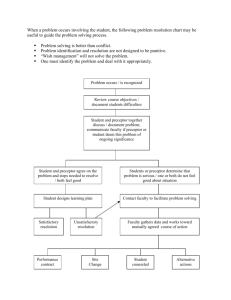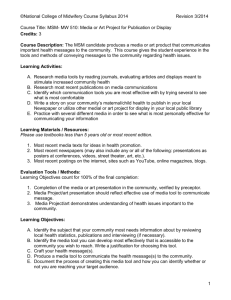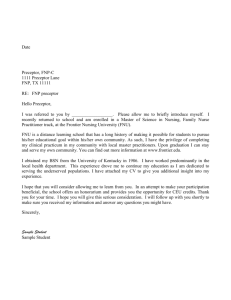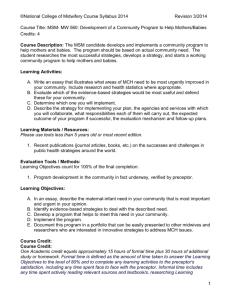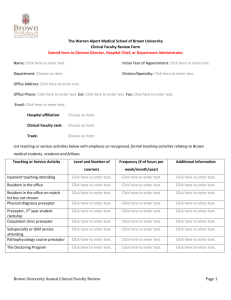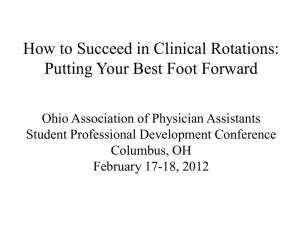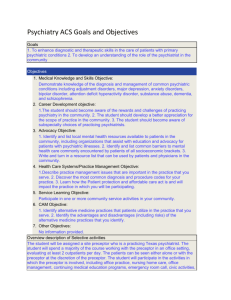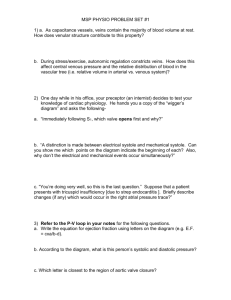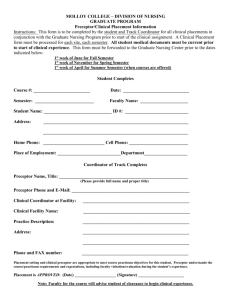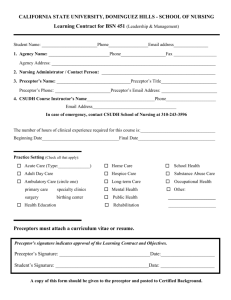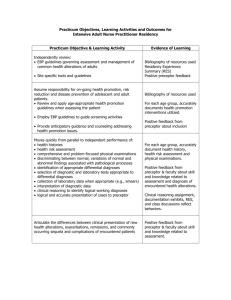completed SAO form
advertisement
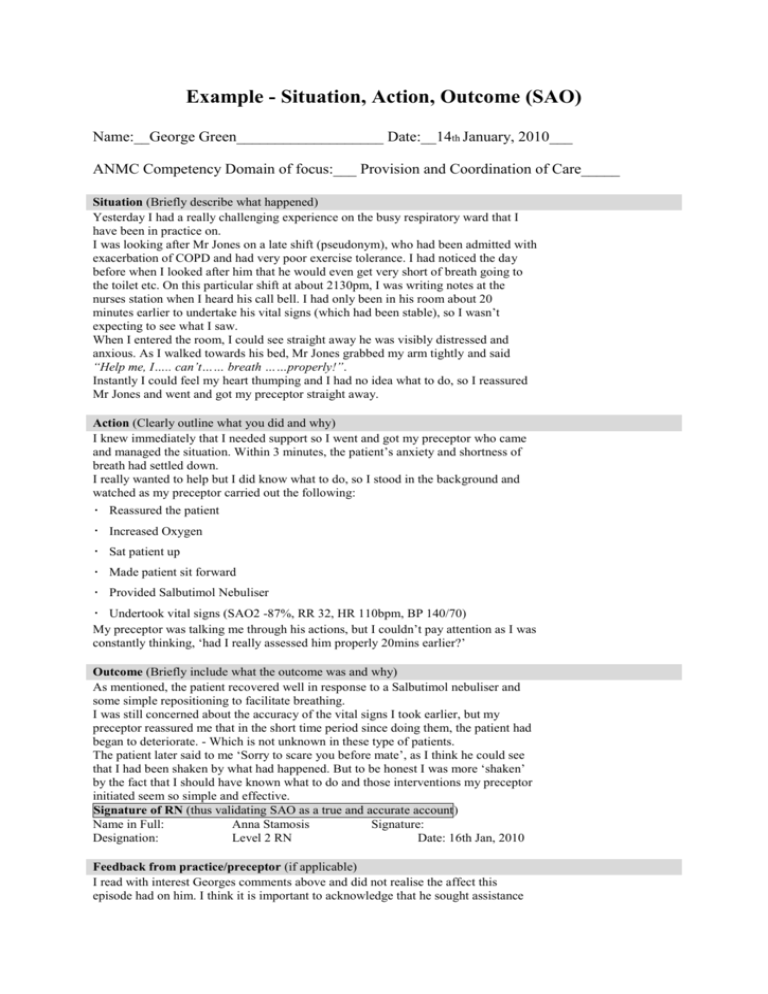
Example - Situation, Action, Outcome (SAO) Name:__George Green___________________ Date:__14th January, 2010___ ANMC Competency Domain of focus:___ Provision and Coordination of Care_____ Situation (Briefly describe what happened) Yesterday I had a really challenging experience on the busy respiratory ward that I have been in practice on. I was looking after Mr Jones on a late shift (pseudonym), who had been admitted with exacerbation of COPD and had very poor exercise tolerance. I had noticed the day before when I looked after him that he would even get very short of breath going to the toilet etc. On this particular shift at about 2130pm, I was writing notes at the nurses station when I heard his call bell. I had only been in his room about 20 minutes earlier to undertake his vital signs (which had been stable), so I wasn’t expecting to see what I saw. When I entered the room, I could see straight away he was visibly distressed and anxious. As I walked towards his bed, Mr Jones grabbed my arm tightly and said “Help me, I….. can’t…… breath ……properly!”. Instantly I could feel my heart thumping and I had no idea what to do, so I reassured Mr Jones and went and got my preceptor straight away. Action (Clearly outline what you did and why) I knew immediately that I needed support so I went and got my preceptor who came and managed the situation. Within 3 minutes, the patient’s anxiety and shortness of breath had settled down. I really wanted to help but I did know what to do, so I stood in the background and watched as my preceptor carried out the following: Reassured the patient Increased Oxygen Sat patient up Made patient sit forward Provided Salbutimol Nebuliser Undertook vital signs (SAO2 -87%, RR 32, HR 110bpm, BP 140/70) My preceptor was talking me through his actions, but I couldn’t pay attention as I was constantly thinking, ‘had I really assessed him properly 20mins earlier?’ Outcome (Briefly include what the outcome was and why) As mentioned, the patient recovered well in response to a Salbutimol nebuliser and some simple repositioning to facilitate breathing. I was still concerned about the accuracy of the vital signs I took earlier, but my preceptor reassured me that in the short time period since doing them, the patient had began to deteriorate. - Which is not unknown in these type of patients. The patient later said to me ‘Sorry to scare you before mate’, as I think he could see that I had been shaken by what had happened. But to be honest I was more ‘shaken’ by the fact that I should have known what to do and those interventions my preceptor initiated seem so simple and effective. Signature of RN (thus validating SAO as a true and accurate account) Name in Full: Anna Stamosis Signature: Designation: Level 2 RN Date: 16th Jan, 2010 Feedback from practice/preceptor (if applicable) I read with interest Georges comments above and did not realise the affect this episode had on him. I think it is important to acknowledge that he sought assistance as soon as possible which resulted in successful interventions being initiated for this patient. George feels this episode highlighted his lack of assessment skills and I encourage him to practice physical assessment on consenting patients to build up his knowledge and understanding around this important aspect of nursing care. I am confident that he will be able to achieve this over the next few weeks. I think George should consider this a positive learning experience as it has highlighted to him areas of his practice which require additional focus. Therefore, providing more opportunity to demonstrate competence. Learning Plan (Based on this episode, where do you need to focus your learning?) I agree with Anna’s comments. I felt really uncomfortable with this situation and it is clear that I was not confident in my response. Additionally, I am due to start my graduate position in 6 weeks, so I need to ensure that I really improve my practice. Therefore, I have decided I need to focus on the following areas: Physical Assessment Skills Review my understanding of physical assessment, particularly respiratory assessment, so I am able to better recognise a deteriorating patient. Prioritisation Discuss with my clinical facilitator about increasing my patient load to challenge my prioritisation and time management skills COPD I need to research more into this illness to gain a better understanding of why this population of patients have such poor exercise tolerance and look at the importance of positioning and chest physio in facilitating gas exchange. Competencies met Professional Practice 1.1, 1.2, 1.3, 2.1, 2.3, 2.5, 2.6. Critical Thinking and Analysis 3.5, 4.1, 4.2, 4.4. Provision and Coordination of Care 5.1, 5.2, 5.3, 6.1, 6.2, 6.3, 6.4, 7.1, 7.2, 7.3, 7.4, 7.5, 7.7, 7.8, 8.1, 8.2. Collaborative and Therapeutic Practice 9.1, 9.2, 9.3, 9.5, 10.2, 10.3. Progress/Completion review comments (Clinical Facilitator only-if applicable) Clinical Facilitator: George and I have reviewed this SAO many times over the last few weeks to ensure he is achieving the goals he set himself in his learning plan. Since this incident, I have felt his skills around oxygen therapy have required further development. Therefore, I have set some additional tasks around this area to further benefit his learning. George has really turned his focus towards working on his assessment skills and knowledge base around COPD. This has also been reflected in the feedback from his practice area where it has particularly highlighted the attention to detail he applies in determining his patient’s respiratory status. I feel it would be beneficial now to broaden this focus from respiratory assessment to encompassing whole body assessment as this will help George to improve his understanding of the ‘big picture’ about the patients’ overall condition and therefore further improve his time/patient management. Well done.
